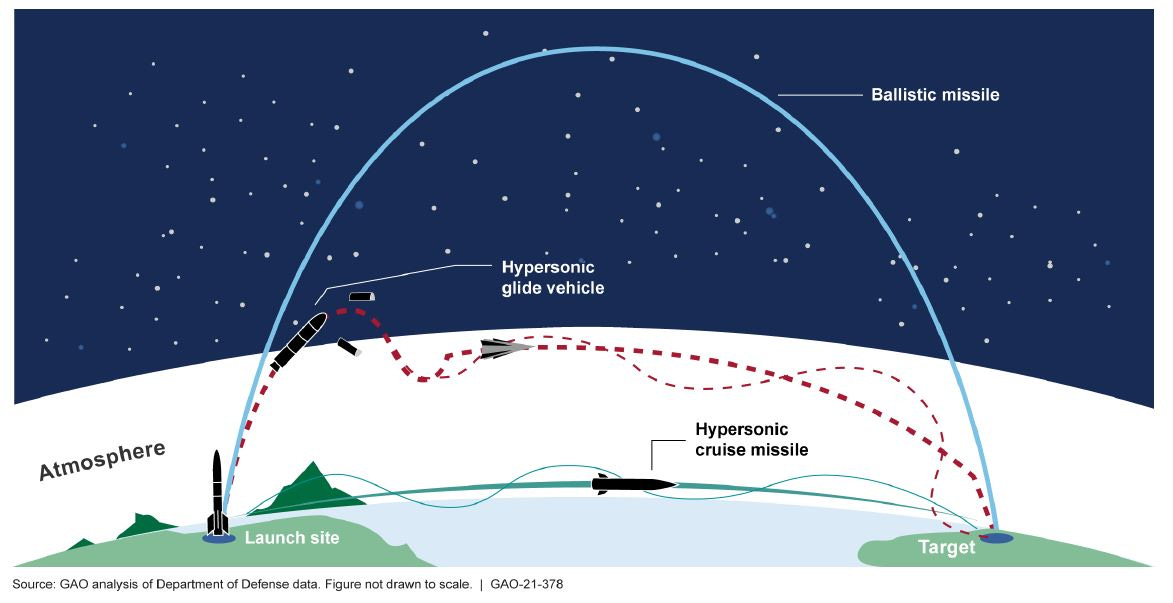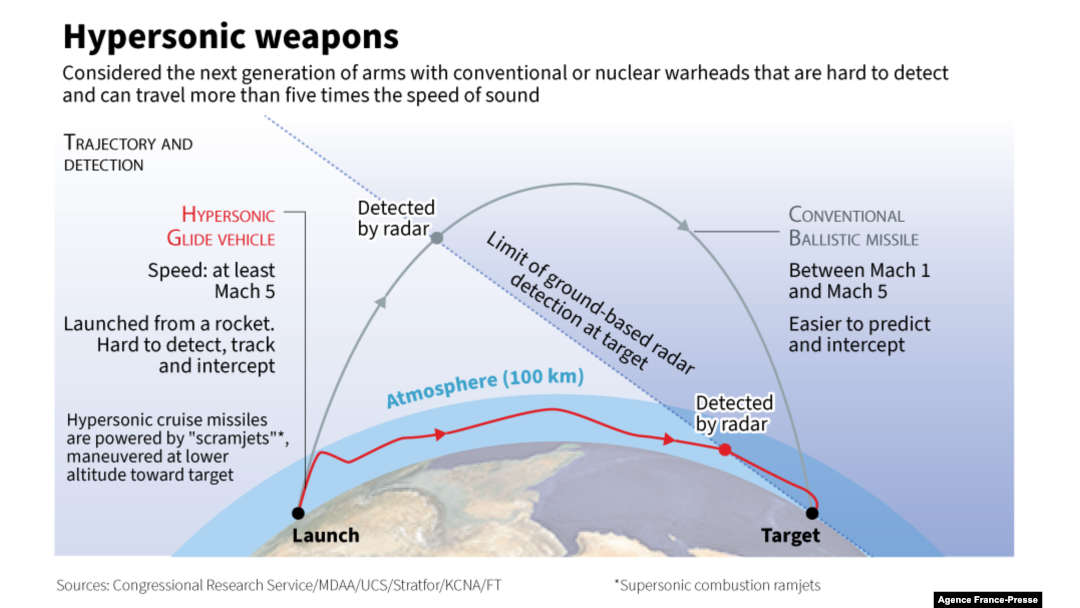Defense Tech and VC Update - January 12, 2025 (Hypersonic Technology | HASC / SASC)
Issue 12 (we are transitioning to a monthly schedule; the next edition will be published on February 9)
Deep Dive - Hypersonic Technology
What is hypersonic flight?
Hypersonic flight is flight at altitudes below 90 kilometers (56 miles) that is greater than 5x the speed of sound (Mach 5+), or approximately a mile a second.
Why do we care about hypersonic flight right now?
Great power competition is currently re-igniting interest in hypersonic flight and weapons. Hypersonic weapons can 1) be deployed quickly and 2) evade interception due to flying in low altitudes at high speeds. Programs include:
Russia: Avangard, Kinzhal, Tsirkon
China: DF-17 / DF-ZF, Xing Kong-2
United States: Conventional Prompt Strike, Long-Range Hypersonic Weapon, Air-launched Rapid Response Weapon, Tactical Boost Glide, Hypersonic Air-Breathing Weapon Concept
Australia: Southern Cross Integrated Flight Research Experiment
UK: Hypersonic Technologies and Capability Development Framework
India: BrahMos II
France: Experimental Maneuvering Vehicle Program / V-Max
Germany: SHEFEX II, ATLLAS II
South Korea: Hycore
North Korea: Hwasong-8
Japan: Hyper Velocity Gliding Projectile
Supersonic and hypersonic flight (e.g., Boom, Spike Aerospace) have re-attracted commercial interest, 20 years after the Concorde was retired. A Tokyo – LA hypersonic flight would take ~2 hours vs. currently ~10 hours.
Hypersonic flight also has attracted space interest. NASA is developing a next-generation reusable hypersonic vehicle for space access, which is attractive because reusable vehicles are cheaper to maintain and faster to refuel / relaunch than building expendable vehicles from scratch.
What are the key terms to know?
There are two types of hypersonic vehicles:
Hypersonic cruise missile (HCM): uses solid rocket propulsion to accelerate to a speed where scramjets take over propulsion for the entire remaining mission
Hypersonic glide vehicles (HGV): uses solid rocket propulsion to accelerate a glide vehicle that continues unpowered for the remaining mission. Glide vehicles are easier to make as they don’t rely on scramjet engines
Scramjet: supersonic combustion ramjet, which relies on high vehicle speeds to “ram” the air into the engine for combustion. Scramjets are efficient at high speeds, making them attractive for hypersonic flight.
Compared with rockets, scramjets are attractive because rockets need to carry oxygen and fuel while scramjets intake oxygen from the atmosphere. As hypersonic flight is within the atmosphere, excess weight and complexity from carrying oxygen in-vehicle can be avoided.
Unfortunately, scramjets do not function until the vehicle achieves ~Mach 3. At lower speeds (including when the vehicle is standing still pre-takeoff), scramjets do not produce usable thrust because they rely on natural airflow to “ram” air into the engine. Conventional jet engines (which have an air compressor to force air into the engine) or rocket engines are needed to achieve the speeds necessary for scramjets to take over.
What are the key opportunities for hypersonic technologies?
The House Armed Services Committee urges the DoD to use Defense Innovation Unit (DIU) and Small Business Innovation Research (SBIR) grants to fund research in hypersonic technologies. The DoD requested $6.9B in FY2025 for hypersonic research (up from $4.7B in FY2023), but there are no programs of record yet for hypersonic weapons.
This is both an opportunity and a risk, as policy can be set to support hypersonic technologies or the DoD may decide to shift resources elsewhere.
Hypersonic technologies can evade current US defenses (e.g., the AEGIS program) given the low flight altitude and high speed, both of which makes tracking and intercepting hypersonic projectiles difficult. If the AEGIS program can be shown to be ineffective against hypersonic threats, budget that would otherwise go to AEGIS can be shifted to funding more effective defenses
There are multiple government programs across different agencies related to hypersonic technologies (DARPA, Army, Navy, Air Force, NASA). Hypersonic technologies will likely support multiple winners, as it appears the government wants redundant programs to increase probability of success. US programs are expected to reach an operational prototype between FY2025 and FY2029.
What are the key considerations in developing hypersonic technologies?
Heat management: the vehicle must handle temperatures above 1,800 degrees Fahrenheit / 1,000 degrees Celsius. Cooling can be passive (heat radiates from surface, only effective up to Mach 6) or active (fuel is used as the coolant, complex but can handle speeds higher than Mach 6)
Vehicle design: design is important to maintain high speeds, especially for glide systems. This has implications for payload capacity (though at high speeds, the kinetic energy released can render the need for conventional payloads irrelevant)
Hypersonic airframes are being built out of aluminum / nickel-based alloys and / or ceramic composites (for their corrosion resistance, strength, and heat absorption capabilities). Current designs include waverider and lifting bodies (all essentially look like triangles).
Guidance and communication: at high speeds, being able to quickly and reliably send and execute instructions is important. Rapid maneuvers may overly stress the vehicle frame. For glide vehicles, excess maneuvering will cost speed and range.
Could hypersonic technologies be a “fad?” Why are current technologies, such as ballistic missiles which travel at similar speeds, insufficient?
Current technologies like ballistic missiles are technically capable of fulfilling mission requirements for the US Conventional Prompt Strike program (accurately strike targets anywhere in the world within one hour). Ballistic missiles are also difficult to intercept due to their high speed and small sizes, and that any large-scale launch by a rival great power would quickly overwhelm defenses.
However, ballistic missiles can carry both conventional and nuclear payloads. To observers, it is impossible to distinguish the difference and their use may dangerously escalate tensions (the Conventional Trident Modification Program was cancelled for this reason).
Developing a hypersonic vehicle whose stated purpose is to only carry conventional payloads may help ease tensions.
Ballistic missiles are estimated to be cheaper than hypersonic missiles. The Congressional Budget Office estimates that purchasing and maintaining hypersonic missiles will cost 33% more than their equivalent in ballistic missiles. The reason for the excess cost is solving for heat management during hypersonic flight.
However, ballistic missiles have been researched, deployed, and refined since the mid-20th century, which is an important timing advantage. With time and research, hypersonic technologies may also decline in cost.
Hypersonic technologies currently serve a niche use case of addressing well-defended and highly time-sensitive threats. Their main value is in reducing time for adversaries to respond. Absent both requirements of time sensitivity and strong defense, conventional sub-sonic cruise missiles or ballistic missiles can accomplish the required tasks.
The most powerful argument why hypersonic technologies are not a “fad” is that rival great powers are developing them, and the US must keep up to maintain parity. Former Undersecretary of Defense for Research and Engineering Michael Griffin testified to Congress stating as such.
Groups like the Union of Concerned Scientists question the need for hypersonic vehicles for defense, but continued government funding for hypersonics is a positive signal.
Preliminary list of interesting companies (ex-major defense primes):
Venus Aerospace (https://www.venusaero.com/): Based in Houston, founded in 2020, raised $20M Series A in Apr-22 from Prime Movers Lab.
Building the Venus Detonation Ramjet Engine (Mach 4 cruise speed, with capability to go faster)
Hermeus (https://www.hermeus.com/): Based in Atlanta, founded in 2018, raised $100M Series B in Mar-22 from Sam Altman, Founders Fund, In-Q-Tel
Building the Chimera (turbojet / ramjet engine), Quarterhorse (test aircraft), Darkhorse (hypersonic drone), Halcyon (hypersonic commercial aircraft)
Ursa Major (https://www.ursamajor.com/): Based in Berthoud (Colorado), founded in 2015, raised $138M Series D in Nov-23 from RTX, Explorer 1
Building Draper (hypersonic engine), Hadley (hypersonic engine), Ripley (small and medium launch engine), and Arroway (heavy launch engine)
Hypersonix Launch Systems (https://www.hypersonix.com/): Based in Australia, founded in 2019, spinout of University of Queensland’s Center for Hypersonics
Building SPARTAN (3D-printed scramjet engine), DART (3D-printed hypersonic airframe), VISR (reusable hypersonic flyer for defense applications), Delta Velos (reusable hypersonic flyer capable of reaching orbit), HyperTwin X (software to simulate hypersonic concepts)
Castelion (https://www.castelion.com/): Based in El Segundo, founded in 2022, raised $14M Series A in Oct-23 from a16z
Building hypersonic test systems, heat shielding, and avionics
Stratolaunch (https://www.stratolaunch.com/): Based in Seattle, founded in 2011
Provides air-launch services to deploy high-speed vehicles in a hypersonic environment (e.g., they provide the initial boost to get your hypersonic vehicle into the required Mach 3 speed)
Other than the defense primes and startups, who else is working on hypersonic technology?
Notre Dame, Purdue, University of Arizona, Texas A&M all have wind tunnels capable of testing flight speeds from Mach 5 through Mach 10. University efforts are coordinated through the Joint Hypersonics Transition Office (JHTO) and the University Consortium for Applied Hypersonics (UCAH)
Recent Funding Rounds
None of note in the last week.
Defense Acronym of the Week - House Armed Services Committee (HASC) / Senate Armed Services Committee (SASC)
The HASC and SASC are responsible for overseeing the US military, defense policy, and DoD, but have important differences:
Both the HASC and SASC independently draft a version of the National Defense Authorization Act (NDAA), which is the annual bill that authorizes defense spending and policies. These drafts will be merged into a final version that passes both the House and Senate
The House version typically focuses on the budget; the Senate version typically focuses on strategy
The Senate committee will confirm military and DoD appointees (e.g., Secretary of Defense, Joint Chiefs of Staff, etc.); the House does not
Tech-Focused DoD Contract Awards
January 6
None of note for tech-related defense procurement
January 7
None of note for tech-related defense procurement
January 8
Navy
$74M (Amazon Web Services): cloud consumption and enterprise support for AWS GovCloud and AWS Marketplace
$59M (Kratos Unmanned Aerial Systems): aerial targets and rocket-assisted takeoff kits
$18M (VSolvit): Enterprise Business Systems Enhanced Operations Environment support services (SBIR Phase 3)
Air Force
$25M (Raft): cloud computing and IT integration in support of Kessel Run operations (Air Force Life Cycle Management Center)
January 10
Air Force
$100M (Modern Technology Solutions): prototyping and delivering processes for space command & control
DARPA
$10M (Joint All-Domain Warfighting Software program, Phase 4 option
Calendar: US Defense Primes Earnings Calls
Lockheed Martin - January 28, 2025
Northrop Grumman - January 23, 2025
General Dynamics - January 22, 2025
Boeing - January 29, 2025
Raytheon - January 28, 2025
Calendar: Other Defense Earnings Calls
L3 Harris - January 23, 2025
Honeywell - January 29, 2025
AeroVironment - March 3, 2025
Palantir - February 3, 2025
Interesting Charts
Difference between ballistic missile, hypersonic glide vehicle, and hypersonic cruise missile






The way you broke down HGVs vs HCMs and scramjets made the rest of the update easier to follow. I’m still wrestling with one question: if glide vehicles are easier to make and the main constraint is heat management, why aren't more startups leaning into thermal solutions instead of full vehicle platforms?
Are there technical limits to modularizing that layer, or is it just that primes already dominate the relevant supply chains?